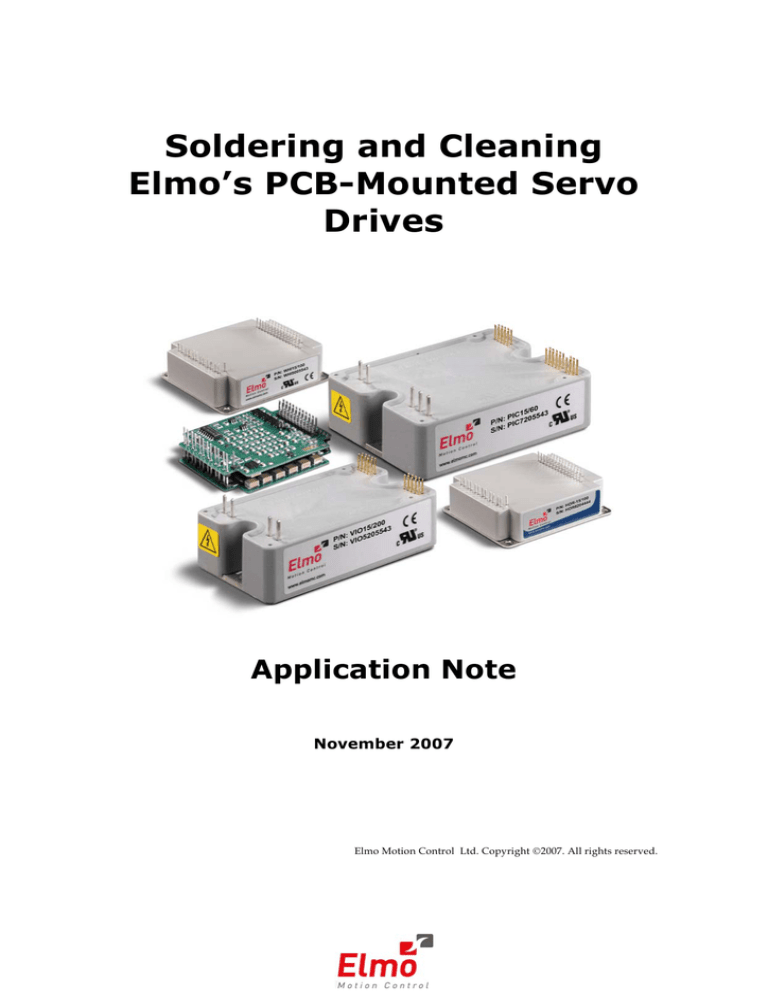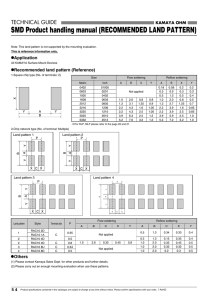
Soldering and Cleaning
Elmo’s PCB-Mounted Servo
Drives
Application Note
November 2007
Elmo Motion Control Ltd. Copyright ©2007. All rights reserved.
Contents
1. Introduction .................................................................................... 3
2. Assembling PCB-Based Products................................................. 3
2.1 Assembly via Connectors ......................................................................................3
2.2 Assembly by Soldering ..........................................................................................4
3. Considerations................................................................................ 5
3
1. Introduction
Elmo has a wide range of PCB-Mounted Servo amplifiers and drives. The essence of PCB
Mounted products is to enable the most efficient assembly and the implementation of Elmo’s
products within the customer’s application.
The PCB-Based Products include the following products:
Violin
Piccolo
Flute
Ocarina
Castanet
Canary
Robin
Raven
Butterfly
Dragonfly
Whistle
Tweeter
Hornet
Bee
Future Products
2. Assembling PCB-Mounted Products
There are two major ways to assemble the PCB-Based products onto the customer PCB:
2.1
Assembly via Connectors
This seems to be the simplest assembly method as the Elmo drive is attached only after PCB
assembly and cleaning has been completed.
The drawbacks of this method are:
•
•
Current Carrying Capacity of the Connectors– Elmo drives produce output current that
exceed the current rating of any available connector
Meeting Application “Ruggedness” Requirements- Ruggedness to prevent mechanical
vibrations, extreme temperatures, humidity, etc. is solved by “simple” soldering and not
via connectors
4
2.2
Assembly by Soldering
Soldering onto the customer’s board, will result meeting the application requirements and
achieve the best performance in:
Current carrying capacity
Highest mechanical ruggedness
Cost effectiveness
Example:
The Duo, 2 Whistle (WHI) Drives in the Assembly
• The WHI Drives are soldered onto the Interface Board
•
“Selective Wave Soldering” with “No Clean” soldering paste was used
Soldered Whistle
5
Soldering Elmo’s PCB-Based Drive Products is simple and straightforward when done
properly. The soldering can be done in any “conventional” way:
1. Wave soldering
2. Selective wave soldering
3. “Hand” soldering
3. Considerations
In all methods, the following considerations must be taken into account:
1. Coating. All Elmo assembled PCBs are coated by a conformed coating that results in
a significantly higher resistance to humidity and polluted environments (Elmo’s
standard coating is the acrylic HumiSeal - 1B31)
2. Some cleaning methods involve cleaning with solvents and then dipping in water (or
other “conducting” liquids) to get rid of the residues and the solvents
Such a cleaning method may cause:
1. The acrylic protective coating to dissolve thus exposing the product to higher
sensitivity to humidity
2. Water (or any other conductive liquid) to be trapped in the product. Even though the
cleaning process has a drying stage for the product, the drying process may never
fully dissipate the liquid completely allowing the wetness to remain within the
product.
The scenario above, of stripping off the conformal coating plus the “trapped water” might
cause destructive short circuits on “Power On”.
The Best and Recommended Assembly Process options are:
Method 1: No Cleaning Required
1. No cleaning at all by using “Non-Clean” soldering pastes
a. Remark: Using “Non-Clean” soldering paste and operating at high temperatures
such as “higher than 60ºC” may cause “re-activating” of the Non-Clean Flux
residues. In very extreme cases, this may result in conduction paths. Therefore,
when the product operates at high temperatures it is recommended to also clean
the “Non-Clean” paste residues. The simplest method is by hand brushing.
2. No need to clean when using a Nitrogen “environment” (hand station or Nitrogen wave
soldering) with fluxless soldering pastes
6
Soldering using
Nitrogen
An example of Nitrogen hands soldering station:
Remark: The world is becoming “greener and greener’ and the “clean” (no fluxes, no residues, no
pollution) Nitrogen soldering (Hand and wave soldering) will become more and more popular.
In addition, the Nitrogen soldering environment ensures the high quality of the soldering
process. Elmo is gradually implementing this “Clean and Qualitative” soldering method to all
Elmo products.
Method 2: Clean Simply
This method is used when cleaning is required after soldering with flux solder paste:
The cleaning process should be done by hand using a soft brush. Simply and gently brush the
cleaning agent on the area needing to be cleaned.
Remark: If the Interface Board is “heavily” populated with components it recommended to:
Option 1:
1. Wave soldering the whole assembly including the Elmo drive
2. Hand cleaning of the whole assembly
Option 2:
1. Wave soldering of the assembly without the Elmo drive
2. Clean the assembly using any method
3. Hand soldering the Elmo drive onto the interface board
4. Hand clean the Elmo drive soldering pins if required
7
Immersion of the boards in cleaning baths or spray cleaning of any kind are absolutely
forbidden by all means.
1. Immersion is
FORBIDDEN
2. Cleaning by hand
brushing is
recommended.
DO NOT PRESS WHEN BRUSHING AND PAY
ATTENTION NOT TO SPLASH THE CLEANER AND
THE RESIDUES


